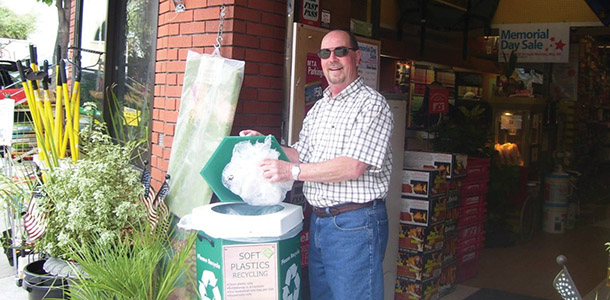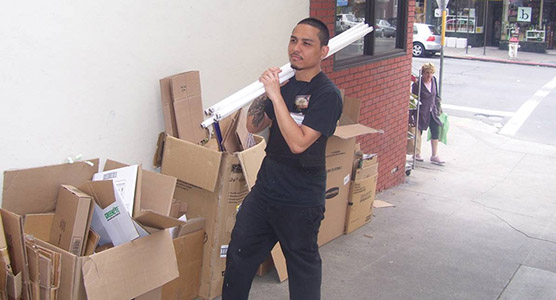Bay Area retailer Cole Hardware was one of four companies honored last month by the California Product Stewardship Council (CPSC) at the organization's annual Arrow Awards ceremony in Los Angeles.

Cole Hardware’s take-back program earned the company top honors at a California Product Stewardship Council awards ceremony held last month. Customers of the Bay Area retailer can drop off unwanted landfill-unfriendly items at any Cole location for proper disposal. Photo by Cole Hardware
By Bill Picture
Published: September, 2015
Bay Area retailer Cole Hardware was one of four companies honored last month by the California Product Stewardship Council (CPSC) at the organization’s annual Arrow Awards ceremony in Los Angeles. The San Francisco-based company’s longstanding take-back program, which encourages customers to drop off landfill-unfriendly waste for safe disposal, earned Cole Hardware an award in the category of “Service and Take-Back.”
“It’s very exciting,” said Julia Strzesieski, marketing coordinator for Cole Hardware. “We started doing this nearly 20 years ago, and we’re astonished by how much we collect on a yearly basis. And the amount we collect seems to be growing every year.”
Cole Hardware, which operates four stores in San Francisco and one in Oakland, was one of the first retailers to participate in the San Francisco Retail Household Hazardous Waste Collection Program (HHW Program), which was launched in 1997. Under that program, consumers can take specified items like paint, batteries, fluorescent lights and propane tanks to participating retailers and other drop-off sites for collection by Recology.
Last year, 24 percent of the items collected under San Francisco’s HHW Program came through Cole Hardware stores. “It’s great that people now know they can bring these items to our stores,” said Strzesieski. “It’s a pretty remarkable program. If it didn’t exist, many of these items would end up in garbage cans and dumpsters, where they can do so much harm.”
While the items collected by Cole Hardware and its fellow participating retailers account for a small percentage of the overall waste stream, they have an outsize impact on the environment, said Heidi Sanborn, executive director of the CPSC.
“The problem is that these products are toxic by nature,” she said. “We don’t want them going into recycling bins at home because then the people who work at sorting facilities get exposed. And we don’t want them going into garbage cans and ending up in landfills, where they contaminate the soil. It’s much safer—not to mention cheaper because it’s extraordinarily expensive to remove these chemicals from the soil once they’ve gotten in there—to think ahead to what’s going to happen to a product when it reaches its end of life and come up with a way to manage it.”
According to Sanborn, the key to the success of a program like San Francisco’s is convenience. “People want to do the right thing, but we make it so hard for them,” she said. “We make them dig for the answers, or drive out to some hazardous waste facility. It should be easy and it’s not. And that’s a big problem.”
Sanborn said that the CPSC periodically conducts focus groups where participants are asked what can be done to help them step up their recycling game. “And they say, ‘Just tell us what we’re supposed to do and make it easy for us to do it, and we’ll do it.’ They’re frustrated, and I don’t blame them.”
Eco hot potato
Some industries have been leaders when it comes to what happens to their products and packaging post-life. For instance, the American Coatings Association, which represents paint manufacturers, created PaintCare in 2009. Under that program, unwanted paint can be dropped off at participating retail locations, and the bill for collection and disposal is entirely footed by the industry that made the product in the first place.
“That’s what should be happening across the board,” Sanborn said. “The manufacturers should be the ones dealing with this problem. But dealing with it costs money, and because these companies answer to their shareholders, that’s not happening. So 100 percent of the end-of-life cost of a product ends up getting externalized. In the end, you and I are paying for it.”
While the number of smaller retailers participating in take-back programs like San Francisco’s continues to grow, Sanborn says the response from big-box stores has been disappointing. “Home Depot doesn’t want to take back paint,” she said. “Imagine what a difference they could be making, but they don’t want to. We need to put pressure on these big retailers to step up and do their share, because they’re not.”
In some countries, like Canada for instance, the cost associated with the safe disposal of a product is figured into its purchase price. Sanborn said CPSC has proposed this to its focus groups, and participants overwhelmingly agreed it was a good idea.
“They said, ‘Do it so we don’t even have to think about it.’ But I don’t know that America would really go for that. What I do know is that if we don’t soon start pricing things correctly based on their life cycle, we’re going to have big problems. The population continues to increase and the amount of land available for disposal is shrinking fast.”
In the mix
According to Eileen Leung, who works at the San Francisco Department of the Environment, the City’s HHW Program collected 9,000 gallons of batteries (alkaline and rechargeable) last year, along with 15,600 gallons of paint, 33,500 fluorescent tubes and just under 50,000 light bulbs. Out of those items, paint was the only item returned to the manufacturers.
“There isn’t much we won’t take back,” said Strzesieski at Cole Hardware. “People come to us with all sorts of things—we see a lot of string-lights around the holidays—and most of the time, we can take it. Even if we can’t take something and have to refer them to Recology or the Department of the Environment, I think it’s great that people look to us as a resource.”
Sanborn is keeping a close eye on smoke detectors (which contain a small amount of radioactive material), mercury thermostats, carpet, mattresses, pharmaceuticals and syringes, all of which continue to end up in the waste stream. Legislation is being crafted to keep some of these items out of landfills.
“There’s a bill in the legislature right now for needles and batteries,” she said. “The pharmaceuticals bill didn’t pass but some counties passed measures of their own.” Meanwhile, she said, “Canada has programs in place for all of these items. Even the Mexican government has a pharmaceutical take-back program. What we need in this country is a huge paradigm change, because we’re getting wildly behind.”
For more information on California Product Stewardship Council and the Arrow Awards, visit www.calpsc.org.

Spent fluorescent tubes are among the items than Cole Hardware will take back as part of the San Francisco Retail Household Hazardous Waste Collection Program, an ongoing collaboration with Recology and the SF Department of the Environment. The tubes contain elements that are toxic and will contaminate soil at landfills, especially if they get wet. Photo by Cole Hardware

Most of the unwanted items deposited at Cole Hardware stores are picked up by Recology for safe disposal. Paint, however is returned to the manufacturer for disposal, part of a take-back program paid for by the paint industry. Photo by Cole Hardware

